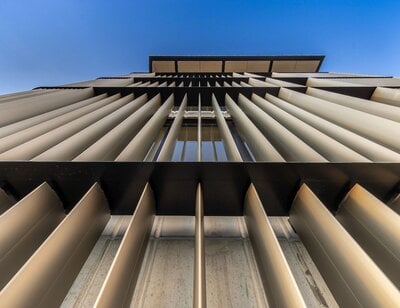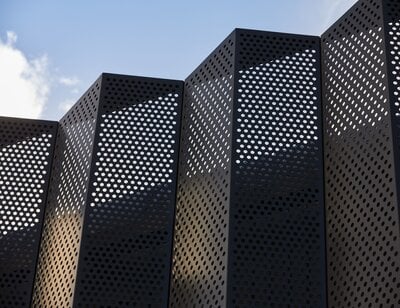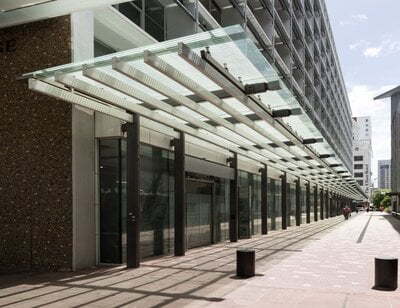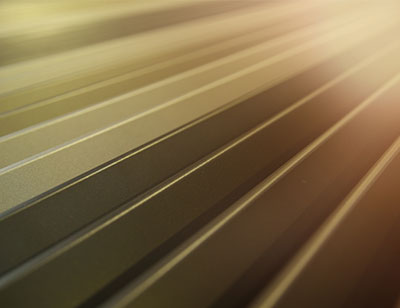As we all know, Aluminium louvres are a uniquely effective way to overcome the common architectural problems of glare and solar gain.
Nothing else has quite the same versatility, and aluminium louvres are here to stay as a crucial part of architecture. However, aluminium louvres can be a costly item on the schedule and justifying their existence can be difficult. It is important to ensure they are specified carefully for the most effective performance.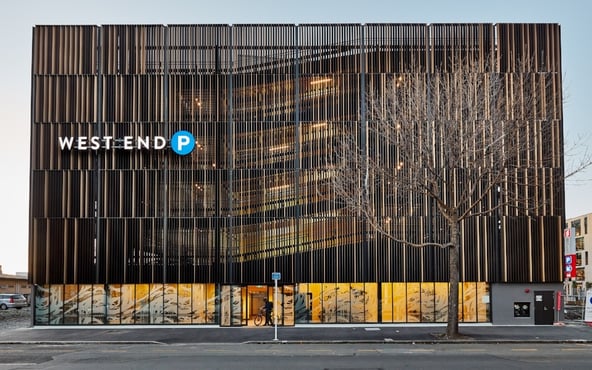
At Insol, we have 5 basic questions we ask ourselves - read on for more info.
Looking for different ways to use louvre facades? Download our free Impressions Guide for more unique façade work from around New Zealand. Get your copy here.
1. Are you using louvres to reduce glare, or to reduce solar gain?
This is a fairly basic point but if you get it wrong there can be major consequences. Consider this;
We recently completed a project on a swimming pool. The louvres had been well detailed and specified by the architect. 6 months down the track, in the middle of winter when the sun is at its lowest, we get a call from the building owner (local council) asking if we can change the louvres to reduce the glare on the water. The lifeguards inside were getting blinded by sunstrike and it was becoming a major health and safety issue.
Now it may never have been in the architects brief that they were to provide louvres to completely prevent sunstrike - sometimes things do get overlooked. But if they'd been in the know, it would have been a very simple thing to get right at design stage. A quick look at the minimum vertical sun angle on that elevation, and a 2D drawing to analyse the best centers and tilt for the selected louvre profile would have been all it took to decide if the design was fit for purpose or if further analysis and design work were needed.
The same can apply when specifying to reduce solar gain. The mechanical engineer may have designed the HVAC system based on a certain reduction in solar gain provided by the louvre array. If this reduction is not realised it can have serious effects on the running costs and occupant comfort further down the track.

2. How much sunlight do you need the louvres to block, and at what dates and times?
It's no secret that the suns position in the sky varies widely depending on time of day and year.
Can you nail down the specific times you need maximum sun control? For example, if you're designing a school classroom the occupancy levels drop dramatically every day at 3pm, and they are not occupied at all during the hottest weeks of the year (in the southern hemisphere).
In climates with extreme temperatures, it is mostly desirable to make the most of the solar gain during winter months.
Sometimes a fixed louvre system is simply not going to be flexible enough to meet your requirements, and maybe you should specify a motorised system.
One client wanted an impressive solution with both light and complete blockout, resulting in a mortised louvre solution. Check out the video of the finished project below.
3. Is there a view that needs to be maintained?
In NZ we are blessed with some of the finest scenery in the world. Are the louvres going to obstruct that view? You may need to consider sliding or hinging panels, maybe motorised louvres, or a combination.
We had the experience once of removing some freshly installed louvres, because the homeowner could no longer see the top of a nearby mountain from his favourite chair!
-589724-edited.jpg?width=592&height=395&name=15678_35%20Marine%20Parade_Custom%20140%20Victorian%20Ash_Operable%20%20(24)-589724-edited.jpg)
4. East, West, North, South - What elevation are you shading with louvres?
The orientation of the elevation that you need solar control on, can dramatically affect the configuration of the louvres. For example, vertical louvres perpendicular to the wall on a north elevation will do virtually nothing when the sun is hottest. However, simply change them from vertical to horizontal and you have a completely different result. Sure, more sun hits the windows in morning and afternoon but that sun is at a much lower kW/m2 than midday sun.
5. Are you using louvres effectively? Could you ease budget pressures?
We know there are a lot of factors to consider here. Sometimes a great money saving idea on one element, will be offset by an undesirable effect on another element.
However, some projects are easy to save money on and it is worth considering a few of these points:
- Could you put more tilt on the louvres and space them further apart? For example, if you have 200mm Aurora® louvres at 200mm centers and 15°tilt on a north elevation, you could increase the tilt to 30° and increase the centers to 250mm without compromising the shading effect. This would mean that a 1m high louvre bank could have 4 louvres instead of 5 - a 20% reduction in material!
- If the louvres are under an overhanging soffit, are the top ones doing any work? Could they be removed?
- Are there terrain shading considerations? Do those beautiful alps block the afternoon sun on that elevation for most of the year?
- Could a different louvre be used? There might be a similar sized blade that is substantially cheaper. For example you may have you heart set on using the Solaris® 200 louvre blade but the Solaris® 180 louvre blade may do the job just as well and it is significantly more economical.
This list is by no means comprehensive, but it gives you a basic idea of what needs to be considered into the design of your louvres for solar control. Some careful thought may save quite a bit of money on the right job.
If you need help developing the right louvre design for your project or simply want a second opinion, share your designs with the Insol team to get advice on best steps forward.

